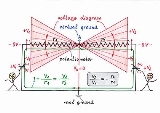
Virtual ground
Encyclopedia
Virtual ground is a node of the circuit that is maintained at a steady reference potential, without being connected directly to the reference potential. In some cases the reference potential is considered to be that of the surface of the earth, and the reference node is called "ground" or "earth" as a consequence.
The virtual ground concept aids circuit analysis in operational amplifier and other circuits and provides useful practical circuit effects that would be difficult to achieve in other ways.
In circuit theory, a node may have any value of current or voltage but physical implementations of a virtual ground will have limitations of current handling ability and a non-zero impedance
which may have practical side effects.

 An active virtual ground circuit is sometimes called a rail splitter
An active virtual ground circuit is sometimes called a rail splitter
. Such a circuit uses an op-amp or some other circuit element that has gain. Since an operational amplifier
has very high open-loop gain
, the potential difference between its inputs tend to zero when a feedback network is implemented. To achieve a reasonable voltage at the output (and thus equilibrium in the system), the output supplies the inverting input (via the feedback network) with enough voltage to reduce the potential difference between the inputs to microvolts. The non-inverting (+) input of the operational amplifier is grounded; therefore, its inverting (-) input, although not connected to ground, will assume a similar potential, becoming a virtual ground.
is a differential quantity, which appears between two points. In order to deal only with a voltage (an electrical potential) of a single point, the second point has to be connected to a reference point (ground
). Usually, the power supply terminals serve as steady grounds; when the internal points of compound power sources are accessible, they can also serve as real grounds.
If there are not accessible source internal points, external circuit points having steady voltage with respect to the source terminals can serve as artificial virtual grounds. Such a point has to have steady potential, which does not vary when a load is attached.
The virtual ground concept aids circuit analysis in operational amplifier and other circuits and provides useful practical circuit effects that would be difficult to achieve in other ways.
In circuit theory, a node may have any value of current or voltage but physical implementations of a virtual ground will have limitations of current handling ability and a non-zero impedance
Electrical impedance
Electrical impedance, or simply impedance, is the measure of the opposition that an electrical circuit presents to the passage of a current when a voltage is applied. In quantitative terms, it is the complex ratio of the voltage to the current in an alternating current circuit...
which may have practical side effects.
Construction
A voltage divider, using two resistors, can be used to create a virtual ground node. If two voltage sources are connected in series with two resistors, it can be shown that the midpoint becomes a virtual ground if

Rail Splitter
Rail splitter may refer to:*Abraham Lincoln, American President*The Rail Splitter Wind Farm, a 100-MW generating complex located in Illinois and named in honor of President Lincoln...
. Such a circuit uses an op-amp or some other circuit element that has gain. Since an operational amplifier
Operational amplifier
An operational amplifier is a DC-coupled high-gain electronic voltage amplifier with a differential input and, usually, a single-ended output...
has very high open-loop gain
Open-loop gain
The open-loop gain of an operational amplifier is the gain obtained when no feedback is used in the circuit.Open loop gain is usually exceedingly high; in fact, an ideal operational amplifier has infinite open-loop gain. Typically an op-amp may have an open-loop gain of around 10^5...
, the potential difference between its inputs tend to zero when a feedback network is implemented. To achieve a reasonable voltage at the output (and thus equilibrium in the system), the output supplies the inverting input (via the feedback network) with enough voltage to reduce the potential difference between the inputs to microvolts. The non-inverting (+) input of the operational amplifier is grounded; therefore, its inverting (-) input, although not connected to ground, will assume a similar potential, becoming a virtual ground.
Applications
VoltageVoltage
Voltage, otherwise known as electrical potential difference or electric tension is the difference in electric potential between two points — or the difference in electric potential energy per unit charge between two points...
is a differential quantity, which appears between two points. In order to deal only with a voltage (an electrical potential) of a single point, the second point has to be connected to a reference point (ground
Ground (electricity)
In electrical engineering, ground or earth may be the reference point in an electrical circuit from which other voltages are measured, or a common return path for electric current, or a direct physical connection to the Earth....
). Usually, the power supply terminals serve as steady grounds; when the internal points of compound power sources are accessible, they can also serve as real grounds.
If there are not accessible source internal points, external circuit points having steady voltage with respect to the source terminals can serve as artificial virtual grounds. Such a point has to have steady potential, which does not vary when a load is attached.
See also
- Voltage-to-current converter and Current-to-voltage converter show some typical virtual ground applications
- Miller theorem applications
External links
- Inverting configuration shows the application of the virtual ground concept in an inverting amplifier
- Create a Virtual Ground with the LT1118-2.5 Sink/Source Voltage Regulator
- Rail Splitter, from Abraham Lincoln to Virtual Ground Application note on creating an artificial virtual ground as a reference voltage.

